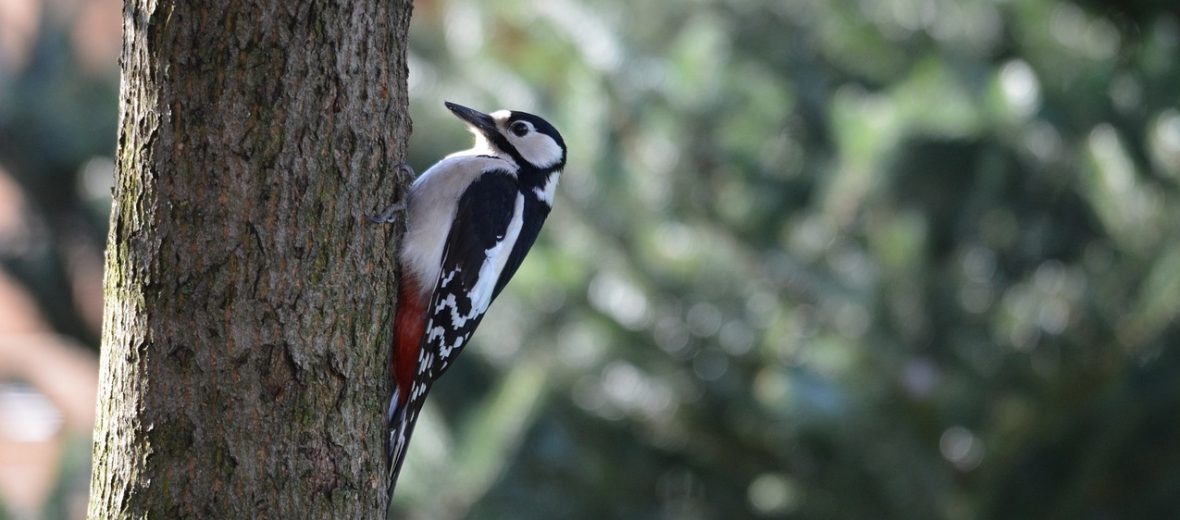
The great spotted woodpecker is widely distributed throughout Europe, Asia, and into Northern Africa. They can tolerate a wide variety of habitats, including: broadleaf forests, coniferous and/or mixed forests, woodlands, gardens, olive groves, and parks. Even though they face the threats of deforestation and climate change, these birds are numerous and their numbers are increasing. The IUCN lists them as Least Concern. They have an estimated population of a whopping 111,000,000 wild individuals!
First the Stats…
Scientific name: Dendrocopos major
Weight: Up to 3.5 ounces
Length: Up to 9.4 inches
Wingspan: Up to 15 inches
Lifespan: Up to 11 years
Now on to the Facts!
1.) Some populations have been known to migrate if the amount of pine and spruce cone availability drops too low.
2.) These birds are typically solitary, but they have been seen in mated pairs as well.
3.) Like all woodpeckers, they will drum to advertise territory and to find a mate.
4.) Up to 4 inch holes are bored into trees to obtain grubs. If they can’t extract the grub with their beak, they utilize their long, sticky tongue to do so.
5.) Their tongue is elongated, covered with bristles, and sticky saliva, and is not only used for grub extraction but for cushioning when the bird is drilling holes in trees.
But wait, there’s more on the great spotted woodpecker!
6.) When drumming or drilling holes in trees, their tongue recedes far back into their head and cushions their brain from trauma.
7.) Great spotted woodpeckers are primarily diurnal (active during the day).
Did you know…?
These woodpeckers have been documented using tools to both open pinecones and to disarm insects. They find a portion of a tree and use it as an anvil to smash open the pinecones, nuts, and to disarm harmful insects before eating them.
8.) Vocal communication consists of various calls, such as a “kik,” “gwig,” and “krrarraarr” sounds.
9.) A group of woodpeckers is called a descension, drumming, descent, fall, or gatling.
10.) Their diet is that of an omnivore (eats plant and animal matter) and consists of ants, beetles, spiders, crustaceans, snails, other bird’s eggs and chicks, seeds, suet, buds, berries, nuts, conifer seeds, tree sap, table scraps, and even carrion (dead animals).
But wait, there’s still more on the great spotted woodpecker!
11.) Being serially monogamous, these birds will stay with their chosen partner for most if not all of the breeding season, only to leave them for another partner, before or after the chicks are reared.
12.) Nests sites are rarely, if ever, reused. But the same structure is often reused for nesting for several years.
Did you know…?
They are able to easily navigate trees as they are equipped with zygodactyl feet (2 toes facing forward and 2 facing backward).
13.) The nest that is created is never lined, sans left over wood chips.
14.) Females lay up to 6 eggs that hatch in up to 12 days.
15.) Chicks fledge in up to 33 days.
But wait, there’s still a little more on the great spotted woodpecker!
16.) Their drumming is among the fastest of any other woodpecker species in their range. They drum at up to 10-16 strikes per second!
17.) These, like other woodpeckers possess narrow nostrils that help keep flying debris from entering their nasal passages.
Now a Short Great Spotted Woodpecker Video!
Be sure to share & comment below! Also, check out the Critter Science YouTube channel. Videos added regularly!
Want to suggest a critter for me to write about? Let me know here.
Some source material acquired from: Wikipedia & IUCN.



